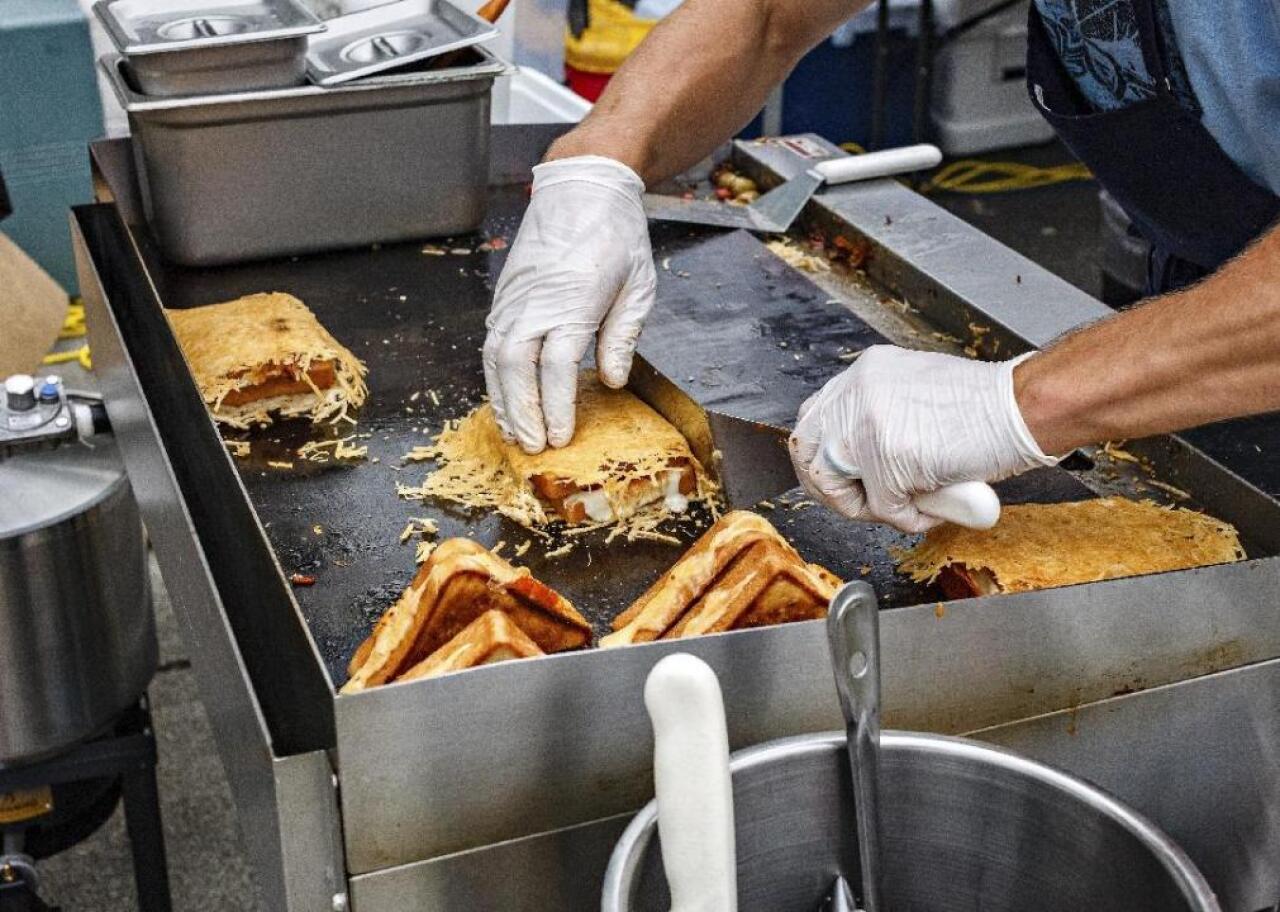50 lowest-paying jobs in America

Tada Images // Shutterstock
50 lowest-paying jobs in America
Inflation in the United States has skyrocketed in recent years, and though nationwide rates sit at 2.7% as of July 2025, the cost of living is only expected to increase in the coming months. As President Donald Trump imposes tariffs against key trade partners like Canada, Mexico, and China, American consumers should expect to see much higher price tags. In the meantime, three states—Alaska, California, and Oregon—and more than a dozen cities enacted minimum wage increases on July 1, 2025. However, some experts have expressed concerns that this still won’t be enough to keep up with rising costs.
Low-income families are hurt more by inflation for a number of reasons, according to the Federal Reserve Bank of Dallas. They spend a higher proportion of their income on food, gas, and rent—necessities whose price increases are greater than average—and so have fewer options to reduce their spending. Middle-income households might buy cheaper goods to cut their costs, but low-income households are often already doing just that. And low-income families often don’t have the resources to buy in bulk to save or to buy at a discount online, as well as having smaller cash reserves, the Federal Reserve Bank notes.
To determine which workers have the bleakest prospects, Stacker identified the 50 lowest-paying jobs in the U.S. using May 2024 data from the Bureau of Labor Statistics, which was published in April 2025. Jobs are ranked according to their median annual wage, and median hourly wage and total employment nationwide are also listed. Positions without reported annual wages—not calculated by the BLS due to the nature of the work—were excluded from this analysis. Additionally, any jobs that were listed as “all other” in the occupation name were excluded from the list, because those are groupings of jobs, and the data may not accurately reflect every job in that grouping.
Keep reading to learn which of the nation’s occupations pay barely livable wages, and see how your job stacks up to others on the list.
Monkey Business Images // Shutterstock
#50. Waiters and waitresses
– Mean annual wage: $38,360
– Mean hourly wage: $18.44
– Total employment: 2,302,690
This occupation is one of the most common first jobs in the United States. While it requires no formal education, most waiters and waitresses undergo a few weeks of on-the-job training to learn how to serve food, communicate with kitchen staff, and prepare dining areas. Workers who get jobs at upscale restaurants in big cities and vacation areas can make significantly more money in tips.

Drazen Zigic // Shutterstock
#49. Library assistants, clerical
– Mean annual wage: $37,910
– Mean hourly wage: $18.22
– Total employment: 80,070
While librarian roles are reserved for people who have completed a master’s degree, clerical library assistants can enter the field with just a high school diploma and brief on-the-job training. They have basic duties, such as answering phones, organizing files, and maintaining databases. Those who excel in the role may go on to more lucrative positions, such as library supervisors.

MAVV // Shutterstock
#48. Farmworkers and laborers, crop, nursery, and greenhouse
– Mean annual wage: $37,850
– Mean hourly wage: $18.20
– Total employment: 261,690
Workers in this occupation take care of everything needed to grow crops, including pruning, planting, watering, and applying pesticides. While farmworkers tend to fruits, veggies, nuts, and grains, those who work in nurseries and greenhouses may focus on horticultural products, like flowers and trees. Farmworkers and laborers typically learn skills on the job and may advance to managerial positions, such as crew leaders, later in their careers.

Paolo Bona // Shutterstock
#47. Cooks, restaurant
– Mean annual wage: $37,730
– Mean hourly wage: $18.14
– Total employment: 1,452,130Cooks are a broad category—and often an underpaid one—which is why the larger occupation appears multiple times on this list. Restaurant cooks prepare, season, and cook food in a restaurant setting. High schools or vocational programs may offer food service training, and employers often provide on-the-job training. Cooks must sometimes have a food handler’s certification to work in some states and localities.

Shakirov Albert // Shutterstock
#46. Floral designers
– Mean annual wage: $37,700
– Mean hourly wage: $18.13
– Total employment: 40,160
Floral designers arrange blossoms and greenery into decorative displays for some of life’s most important moments, including weddings and funerals. They have an artistic talent for evoking specific sentiments through flowers. While the demand for flower arrangements will remain steady in the coming decade, the nation is projected to need 10% fewer floral designers by 2033, as online flower delivery services widen the geographic footprint of existing shops.

Nomad_Soul // Shutterstock
#45. Bakers
– Mean annual wage: $37,670
– Mean hourly wage: $18.11
– Total employment: 231,890
America has a sweet tooth, and it’s driving up the demand for bakers. The occupation is expected to grow 5% by 2033. Formal education isn’t mandatory for this job, but some workers receive training at technical or culinary schools for up to two years. They may need to start their careers as baker’s assistants before learning the techniques to become full-fledged bakers.

DSBfoto // Shutterstock
#44. Janitors and cleaners, except maids, and housekeeping cleaners
– Mean annual wage: $37,460
– Mean hourly wage: $18.01
– Total employment: 2,199,900Janitors and cleaners have to be willing to take on some serious cleaning, including tasks like scrubbing floors and shampooing rugs. It’s mostly an indoor job, though some outside work, like keeping walkways clear of debris and snow, can be required. The occupation is expected to grow 3% by 2033, which is about the same as all other occupations.

Drazen Zigic // Shutterstock
#43. Cooks, institution, and cafeteria
– Mean annual wage: $37,310
– Mean hourly wage: $17.94
– Total employment: 448,260Cooks in the institution and cafeteria category prepare and cook larger amounts of food for institutions like hospitals, dormitories, retirement homes and other assisted living facilities, and schools. Some food-service jobs in these institutions can be entry level.

Olaf Speier // Shutterstock
#42. Shoe machine operators and tenders
– Mean annual wage: $37,230
– Mean hourly wage: $17.90
– Total employment: 3,270We’re well past the days of the humble cobbler. As the name gives away, shoe machine operators and tenders are more mechanically-oriented, even if the ultimate aims are the same: putting together, decorating, and otherwise finishing shoes. Specific tasks can also include product inspection, meaning you’ll have to know your way around the machines and the shoes themselves.
Oksana Shufrych // Shutterstock
#41. Recreation workers
– Mean annual wage: $37,170
– Mean hourly wage: $17.87
– Total employment: 309,640
Recreation workers lead activities that help people get active and have fun. They are often employed at summer camps, fitness centers, nursing homes, and parks. These are often seasonal or part-time positions with irregular hours, such as weekends. Jobs in this field require a high school diploma, but some may prefer applicants who have a bachelor’s degree.
Monkey Business Images // Shutterstock
#40. Retail salespersons
– Mean annual wage: $37,150
– Mean hourly wage: $17.86
– Total employment: 3,800,250
Retail salespersons work in brick-and-mortar stores to help customers find products, pay for merchandise, and obtain information on store policies. This is an entry-level role in retail, and jobs typically don’t have education requirements. Once a retail salesperson gets experience and demonstrates success, they may be promoted to a supervisory or managerial role.
Pressmaster // Shutterstock
#39. Baggage porters and bellhops
– Mean annual wage: $36,960
– Mean hourly wage: $17.77
– Total employment: 31,220
To break into this occupation, a prospective bellhop needs only a high school diploma and a willingness to learn how to handle baggage. The traveler accommodation industry employs the most baggage porters and bellhops overall.
Finist4 // Shutterstock
#38. Manicurists and pedicurists
– Mean annual wage: $36,910
– Mean hourly wage: $17.74
– Total employment: 147,820
Manicurists and pedicurists’ primary duty is to keep fingernails and toenails clean and beautiful. Workers may need to get a state license to enter this field, which usually requires a state-approved course. Many manicurists and pedicurists say they work in poor conditions despite some states’ efforts to regulate this occupation.
grivet // Shutterstock
#37. Gambling changes persons and booth cashiers
– Mean annual wage: $36,820
– Mean hourly wage: $17.70
– Total employment: 21,930
Gambling change persons and booth cashiers give customers chips, coins, and tokens in exchange for money. They must keep accurate records of transactions, calculate the value of chips, and make changes for patrons. A high school diploma is needed.
UfaBizPhoto // Shutterstock
#36. Sewing machine operators
– Mean annual wage: $36,680
– Mean hourly wage: $17.64
– Total employment: 109,590
This occupation involves using sewing machines to create, reinforce, or decorate garments. However, many of these jobs have moved overseas.

SviatlanaLaza // Shutterstock
#35. Packers and packagers, hand
– Mean annual wage: $36,600
– Mean hourly wage: $17.59
– Total employment: 601,440
Labeling cartons, checking for defective items, and keeping packing records are a few of the primary responsibilities of hand packers and packagers. Formal education is not usually a requirement for this kind of job. As stores incorporate additional self-checkouts and automation takes over at warehouses, this occupation is expected to shrink.

Dmytro Sheremeta // Shutterstock
#34. Locker room, coatroom, and dressing room attendants
– Mean annual wage: $36,490
– Mean hourly wage: $17.54
– Total employment: 14,960
Attendants help patrons at fitness centers, venues, and theaters store their personal items. They may also assist customers using dressing rooms at retail stores. While the average salary for this occupation is low, tips can boost workers’ earnings.
Atstock Productions // Shutterstock
#33. Telemarketers
– Mean annual wage: $36,340
– Mean hourly wage: $17.47
– Total employment: 66,430
Telemarketers call people to request donations or make sales for their company. Workers learn everything they need to know about telemarketing through on-the-job training.
Nejron Photo // Shutterstock
#32. Cleaners of vehicles and equipment
– Mean annual wage: $36,290
– Mean hourly wage: $17.45
– Total employment: 373,960
People who keep vehicles and machinery sparkling clean are in this line of work. They can often find opportunities at a carwash, manufacturing firm, rental car agency, or dealership. With the growing demand for car maintenance services, vehicle and equipment cleaners may see additional employment opportunities open up by 2031.

Dean Drobot // Shutterstock
#31. Shoe and leather workers and repairers
– Mean annual wage: $36,280
– Mean hourly wage: $17.44
– Total employment: 7,640Unlike shoe machine operators, shoe and leather workers and repairers work with leather specifically. That means constructing and repairing leather products, including shoes, luggage, saddles, and more. More detailed, hands-on work can be required, such as dyeing, polishing, and engraving leather.
Rawpixel.com // Shutterstock
#30. Maids and housekeeping cleaners
– Mean annual wage: $36,180
– Mean hourly wage: $17.39
– Total employment: 854,910
Workers in this occupation provide light cleaning services at private homes and commercial establishments, such as hospitals and resorts. Hiring managers typically look for maids and housekeeping cleaners with some work-related experience or knowledge of cleaning.

BearFotos // Shutterstock
#29. Graders and sorters, agricultural products
– Mean annual wage: $36,080
– Mean hourly wage: $17.34
– Total employment: 26,870
Agricultural products and unprocessed foods are graded and sorted by graders and sorters, who categorize the items according to size, color, weight, and other characteristics. Nearly two-thirds of workers in this occupation don’t have a high school diploma. They usually learn how to perform the job from more experienced workers.

Paul.J.West // Shutterstock
#28. Teaching assistants, except postsecondary
– Mean annual wage: $35,960
– Mean hourly wage: Not available
– Total employment: 1,375,300Teaching assistants are also known as classroom aides and work in schools and at religious and child care centers. This job does require two years of college coursework in most cases, but more education and training could bump you up to a higher pay range. Teaching assistants who work in trade schools, business schools, and at psychiatric centers typically earn more, for example.

Krysja // Shutterstock
#27. Funeral attendants
– Mean annual wage: $35,900
– Mean hourly wage: $17.26
– Total employment: 30,560
Workers in this occupation take care of tasks for a funeral, including arranging floral offerings, closing the casket, storing equipment, and escorting mourners. It’s an entry-level role at a funeral home that requires candidates to have a high school diploma or GED and participate in a brief period of on-the-job training. Funeral attendants can advance in their careers by studying funeral service or mortuary science and passing a state licensing exam to become a funeral service manager or director.

Olena Yakobchuk // Shutterstock
#26. Automotive and watercraft service attendants
– Mean annual wage: $35,800
– Mean hourly wage: $17.21
– Total employment: 98,270
While service technicians may repair vehicles, automotive and watercraft service attendants provide more basic maintenance services for vehicles and boats, such as refueling, lubricating, changing oil, replacing lights, and repairing tires. Hawai’i and Connecticut are the top-paying states for this occupation. Workers who complete a post-secondary program or go to vocational school may advance into full-fledged mechanics.
Jason Person // Shutterstock
#25. Cooks, short order
– Mean annual wage: $35,660
– Mean hourly wage: $17.14
– Total employment: 150,420
As the name suggests, short-order cooks prepare and cook food that doesn’t take a long time to make—think orders that can be completed in mere minutes. Short-order cooks can be found at diners, as well as gas stations, amusement parks, and other kinds of eating establishments that emphasize speed. (Fast-food cooks, however, are another category found elsewhere on this list.)

Alexander Oganezov // Shutterstock
#24. Ambulance drivers and attendants, except emergency medical technicians
– Mean annual wage: $35,550
– Mean hourly wage: $17.09
– Total employment: 12,080
Ambulance drivers and attendants play an essential role in transporting people who are sick, injured, or recuperating from an accident. They need to stay cool in emergencies and know how to offer rescue assistance or first aid. Jobs of this type are not projected to grow between 2023 and 2033.

PeopleImages.com – Yuri A // Shutterstock
#23. Physical therapist aides
– Mean annual wage: $35,510
– Mean hourly wage: $17.07
– Total employment: 44,010
Physical therapist aides help prepare treatment areas, wash linens, conduct clerical duties, and transport patients around therapy areas. A physical therapist aide does not need to obtain formal post-secondary education or a state license to work. However, to advance in the field and become a physical therapist assistant, they need to graduate with an associate’s degree from an approved program and become certified.
Richard Thornton // Shutterstock
#22. School bus monitors
– Mean annual wage: $35,270
– Mean hourly wage: $16.96
– Total employment: 72,140
School bus monitors have the sometimes challenging job of keeping order on a school bus. They help students board and leave the bus, and they might report behavioral problems. Some localities require a course to become eligible for the job.

VGstockstudio // Shutterstock
#21. Food servers, nonrestaurant
– Mean annual wage: $35,030
– Mean hourly wage: $16.84
– Total employment: 271,780
Food servers serve food to people outside of restaurants, in places including hospital rooms, hotels, and cars. There are no educational requirements.

PeopleImages.com – Yuri A // Shutterstock
#20. Home health and personal care aides
– Mean annual wage: $34,990
– Mean hourly wage: $16.82
– Total employment: 3,988,140
Home health and personal care aides help people who are old, disabled, or have chronic illnesses with their daily living. They may work in a private or group home or in a day services program. Sometimes, a high school diploma is required, and those working for home health or hospice agencies might need formal training.

rawpixel.com // Shutterstock
#19. Sewers, hand
– Mean annual wage: $34,810
– Mean hourly wage: $16.74
– Total employment: 2,240
Sewers use needles and thread to join, strengthen, or finish manufactured items, such as clothing. Although they are one of the top jobs at risk of complete automation, job numbers are only expected to decline by 12% by 2033.
Pressmaster // Shutterstock
#18. Animal caretakers
– Mean annual wage: $34,750
– Mean hourly wage: $16.71
– Total employment: 277,300
Animal caretaking can be challenging on both emotional and physical levels. Along with feeding, grooming, and bathing animals, caretakers often manage their exercise. Job responsibilities vary depending on whether you are working at a zoo, pet store, kennel, stable, shelter, or clinic.
Gabriel Georgescu // Shutterstock
#17. Hotel, motel, and resort desk clerks
– Mean annual wage: $34,740
– Mean hourly wage: $16.70
– Total employment: 261,430
This traveler-focused worker manages reservations for accommodations, responds to guests’ requests, assigns rooms, maintains occupancy records, and answers phone calls. Knowing how to create spreadsheets can make a clerk more competitive in this field.

Andrey_Popov // Shutterstock
#16. Lifeguards, ski patrol, and other recreational protective service workers
– Mean annual wage: $34,700
– Mean hourly wage: $16.68
– Total employment: 143,590
This occupation monitors areas like pools, beaches, and ski slopes to keep participants safe and potentially save lives in an emergency. Despite its importance, this job pays very little, and workers may need to get additional training to move into a better-paying role.
aboutsung // Shutterstock
#14. Dining room and cafeteria attendants and bartender helpers (tie)
– Mean annual wage: $34,190
– Mean hourly wage: $16.44
– Total employment: 522,010
This is an entry-level role in food service. It involves cleaning tables, transferring dirty plates to the dish room, and stocking service areas. This experience may give attendants the skills they need to advance to more lucrative positions, such as waiters or waitresses.
Martin Smith // Shutterstock
#14. Parking attendants (tie)
– Mean annual wage: $34,190
– Mean hourly wage: $16.44
– Total employment: 134,650
Parking attendants park customers’ cars and deliver them upon their return. They typically hand them a numbered receipt that is later used to identify and collect the vehicle. Parking attendants must have a valid driver’s license and the ability to drive all car types.
Dmitry Kalinovsky // Shutterstock
#13. Laundry and dry-cleaning workers
– Mean annual wage: $33,990
– Mean hourly wage: $16.34
– Total employment: 195,360
Workers in this occupation run machines that wash or dry-clean various items, including cloth garments, blankets, curtains, and carpets. They typically learn how to perform critical duties through on-the-job training.

DenisProduction.com // Shutterstock
#12. Food preparation workers
– Mean annual wage: $33,940
– Mean hourly wage: $16.32
– Total employment: 888,770
Supervised by cooks and chefs, food preparation workers prepare the kitchen and ingredients for the day. They sanitize workstations, cut meats, peel vegetables, and mix salad ingredients. Once they gain enough experience, they may be promoted to assistant or line cooks.

Robert Przybysz // Shutterstock
#11. Pressers, textile, garment, and related materials
– Mean annual wage: $33,370
– Mean hourly wage: $16.04
– Total employment: 26,830
People who use their hands or a machine to get fabrics free of wrinkles are called pressers. Business Insider in 2016 found that this occupation had one of the most significant gender pay gaps, with women earning an average of nearly $9,000 less than their male counterparts each year.

wavebreakmedia // Shutterstock
#10. Dishwashers
– Mean annual wage: $33,220
– Mean hourly wage: $15.97
– Total employment: 471,670
Dishwashers keep a restaurant’s kitchen equipment, utensils, and plates clean. They are one of the lower-paid positions at restaurants, but they require no education.
Krakenimages.com // Shutterstock
#9. Child care workers
– Mean annual wage: $33,140
– Mean hourly wage: $15.93
– Total employment: 520,180
Child care workers take care of youngsters and maintain safe environments at daycare centers, schools, religious organizations, and private homes. People who enjoy this line of work may command higher salaries by earning a bachelor’s degree and becoming preschool directors.

Nick_Nick // Shutterstock
#8. Gambling and sports book writers and runners
– Mean annual wage: $32,570
– Mean hourly wage: $15.66
– Total employment: 7,600
Gambling and sports book writers and runners facilitate bets, helping customers by taking and recording their wagers. They also oversee games, including keno and bingo. A high school degree or equivalent is needed for this job, but a college degree may be required for managers.
Dragon Images // Shutterstock
#7. Hosts and hostesses, restaurant, lounge, and coffee shop
– Mean annual wage: $32,030
– Mean hourly wage: $15.40
– Total employment: 427,150
Hosts and hostesses greet customers and manage reservations and waiting lists. This position can be a stepping stone to becoming a waiter, waitress, or bartender.
Dean Drobot // Shutterstock
#6. Cashiers
– Mean annual wage: $31,810
– Mean hourly wage: $15.29
– Total employment: 3,148,030
Cashiers work directly with customers to process payments for goods and services at stores, gas stations, restaurants, and pharmacies. They are trained on the job and may later advance to better-paying retail positions, such as customer service representatives.

Tyler Olson // Shutterstock
#5. Ushers, lobby attendants, and ticket takers
– Mean annual wage: $31,770
– Mean hourly wage: $15.27
– Total employment: 119,210
Ushers, lobby attendants, and ticket takers handle more straightforward tasks at entertainment facilities. They grant admission to ticketed patrons, help them find their assigned seats, locate lost items, and direct people to restrooms.

BlueSkyImage // Shutterstock
#3. Fast food and counter workers (tie)
– Mean annual wage: $31,350
– Mean hourly wage: $15.07
– Total employment: 3,780,930
Fast food servers assist customers by greeting them, fulfilling their orders, and taking payment. Servers do not need to have formal education. The job is a good fit for high school students looking to gain on-the-job training and experience.

Alexander Oganezov // Shutterstock
#3. Amusement and recreation attendants (tie)
– Mean annual wage: $31,350
– Mean hourly wage: $15.07
– Total employment: 371,590
Workers in this occupation are often responsible for managing schedules at recreation facilities, providing participants with equipment, and operating concession stands and amusement park rides. Most people in this occupation work at amusement parks in California and Florida.

Alena Veasey // Shutterstock
#2. Cooks, fast food
– Mean annual wage: $31,140
– Mean hourly wage: $14.97
– Total employment: 668,230
These cooks prepare meals at fast-food restaurants like McDonald’s and Burger King. Corporations often have training programs that teach fast-food cooks how to perform the tasks at hand. In recent years, some fast-food workers have gone on strike for better wages.

hedgehog94 // Shutterstock
#1. Shampooers
– Mean annual wage: $30,830
– Mean hourly wage: $14.82
– Total employment: 8,890
Shampooers clean customers’ hair at salons. While low-paid, the role gives workers who are interested in hairstyling and cosmetology some hands-on experience in the industry.
Data reporting by Wade Zhou. Additional writing by Louis Peitzman. Copy editing by Paris Close.
![]()























